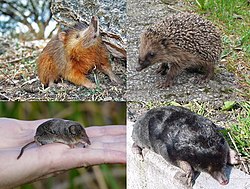Eulipotyphla
Eulipotyphla (/ˌjuːlɪpoʊˈtɪflə/, yang berarti "benar-benar gemuk dan buta"[1]) adalah ordo dalam kelas mamalia yang disarankan oleh metode molekuler dari rekonstruksi filogenetik, dan mencakup anggota-anggota superordo Laurasiatheria dari bekas ordo Lipotyphla yang polifili dan sekarang tidak valid, tetapi tidak mencakup anggota superordo Afrotheria (yang sekarang digolongkan dalam ordo sendiri, Afrosoricida). Lipotyphla sendiri dibuat dengan menghapus sejumlah kelompok dari Insectivora, takson yang sudah tak lagi digunakan.
| Eulipotyphla | |
|---|---|
| Taksonomi | |
| Galat Lua: callParserFunction: function "Template" was not found. | |
| Ordo | Eulipotyphla Peter J. Waddell, Norihiro Okada dan Masami Hasegawa, 1999 |
Eulipotyphla terdiri dari landak susu dan landak susu berambut (keduanya tergolong dalam famili Erinaceidae, sebelumnya berada di bawah ordo Erinaceomorpha yang tak lagi digunakan), solenodon (famili Solenodontidae), Desmanini, tikus tanah (famili Talpidae), dan celurut sejati (famili Soricidae). Celurut sejati, tikus tanah, dan solenodon sebelumnya dikelompokkan dalam ordo Soricomorpha. Namun, Soricomorpha merupakan parafili, karena Erinaceidae adalah kelompok saudara dari celurut.[2][3][4]
Ordo ini adalah klad saudari dari klad Scrotifera; bersama-sama, mereka membentuk superordo Laurasiatheria.
Kladogram tingkat famili dari hubungan kekerabatan Eulipotyphla modern menurut Roca dkk. dan Brace dkk. yaitu:[3][5]
| Eulipotyphla |
| ||||||||||||||||||||||||
Referensi
- ^ Hassan, Mo (2009-10-11). "British Wildlife: N". The Disillusioned Taxonomist blog. Diakses tanggal 2015-11-26.
- ^ Douady, C. J.; Chatelier, P. I.; Madsen, O.; de Jong, W. W.; Catzeflis, F.; Springer, M. S.; Stanhope, M. J. (October 2002). "Molecular phylogenetic evidence confirming the Eulipotyphla concept and in support of hedgehogs as the sister group to shrews". Molecular Phylogenetics and Evolution. 25 (1): 200–209. doi:10.1016/S1055-7903(02)00232-4. PMID 12383761.
- ^ a b Roca, A. L.; Bar-Gal, G. K.; Eizirik, E.; Helgen, K. M.; Maria, R.; Springer, M. S.; O'Brien, S. J.; Murphy, W. J. (2004-06-10). "Mesozoic origin for West Indian insectivores". Nature. 429 (6992): 649–651. Bibcode:2004Natur.429..649R. doi:10.1038/nature02597. PMID 15190349.
- ^ Bininda-Emonds, O. R. P.; Cardillo, M.; Jones, K. E.; MacPhee, R. D. E.; Beck, R. M. D.; Grenyer, R.; Price, S. A.; Vos, R. A.; Gittleman, J. L.; Purvis, A. (2007-03-29). "The delayed rise of present-day mammals". Nature. 446 (7135): 507–512. Bibcode:2007Natur.446..507B. doi:10.1038/nature05634. PMID 17392779.
- ^ Brace, S.; Thomas, J. A.; Dalén, L.; Burger, J.; MacPhee, R. D. E.; Barnes, I.; Turvey, S. T. (2016). "Evolutionary History of the Nesophontidae, the Last Unplaced Recent Mammal Family". Molecular Biology and Evolution. 33 (12): 3095–3103. doi:10.1093/molbev/msw186 . PMID 27624716.
